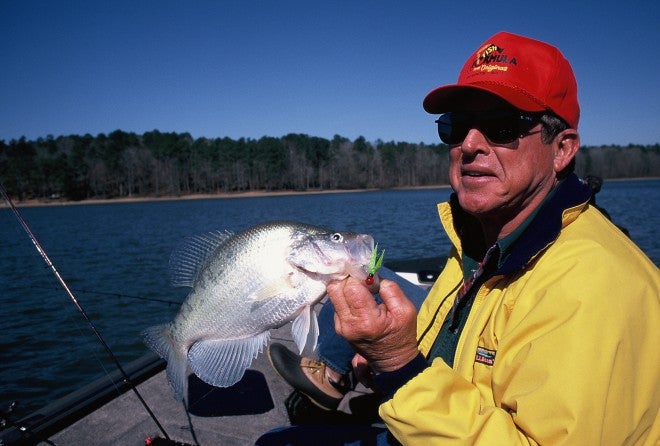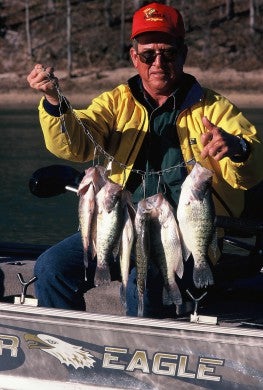Roger Gant on Catching Pre-Spawn Crappies
Bob McNally 03.10.16

Roger Gant has been leading anglers to limit catches of crappies on Pickwick Lake, Tennessee for over 30 years. Few anglers know the lake, and its good-eating fish, better than this mild mannered-Southern gentleman from North Mississippi. While Roger catches fish in all seasons and conditions of the year, for pre-spawn crappies, he is master.
For pre-spawners, he keys on deep, open creek mouths where crappies stage before making their move to headwater and near-shore areas for spawning. He fishes exclusively with bright-colored homemade leadhead jigs of his design, using them with spinning rods positioned strategically along one gunnel of his boat. Roger makes controlled drifts, “pulling” his boat sideways with an electric motor, so six or more rods can be used, each holding a jig positioned slightly off bottom.
“Water depth is a key factor in catching pre-spawn crappies, and you’ve got to put a jig right in their face to get strikes, especially in blustery, cool conditions,” he says.
Roger always drift-trolls using a sensitive fathometer. Knowing that a submerged point of land slowly tapers from 6 to 10 feet, then drops sharply at 12 feet to 15 and then 20 feet gives Roger well-defined “edges” to make effective trolling runs, so his lures and baits are “in the fish zone” for the longest time possible.
An accurate fathometer shows sunken weed beds, rises in a deep structure signifying a “hump,” reveals stump flats and standing deep timber, creek channel edges, even fish and bait. Without a fathometer, Roger says pre-spawn crappie seekers are trolling blind. So if you catch fish you’ll probably not be able to repeat the identical trolling pass, so you aren’t likely to catch additional pre-spawn fish quickly from a school.
“Unless I’m making a specific trolling pass to check out a particular structure or depth, the bulk of my trolling is done parallel to shore,” explains Roger. “This is to learn the contours of the bottom, so any submerged humps or holes, stump flats or unusual bottom configurations can be located. Often pre-spawn crappies will hold tightly to a specific spot, at a certain depth. When you find them, you can really mop up quick.”
Repeated “passes” while running his boat at different depths, monitoring lures, and watching his fathometer, gives Roger detailed information about a pre-spawn crappie fishing area–even places he’s regularly caught fish from. If a lure snags on a stump or rock, he takes careful note of the spot, water depth, shoreline sightings, etc. If he catches a fish or two, he notes the same information and spins the boat back through the area to learn if a school of fish is present. Tossing over a floating marker helps pinpoint the spot, and if it’s red hot, Roger mentally notes the place so he can repeatedly visit the area.
